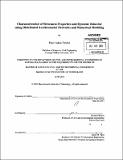| dc.contributor.advisor | Eduardo Kausel. | en_US |
| dc.contributor.author | Trocha, Peter Adam | en_US |
| dc.contributor.other | Massachusetts Institute of Technology. Department of Civil and Environmental Engineering. | en_US |
| dc.date.accessioned | 2013-12-06T20:49:32Z | |
| dc.date.available | 2013-12-06T20:49:32Z | |
| dc.date.issued | 2013 | en_US |
| dc.identifier.uri | http://hdl.handle.net/1721.1/82854 | |
| dc.description | Thesis (S.M.)--Massachusetts Institute of Technology, Department of Civil and Environmental Engineering, 2013. | en_US |
| dc.description | Cataloged from PDF version of thesis. | en_US |
| dc.description | Includes bibliographical references (pages 127). | en_US |
| dc.description.abstract | Both vibration-based structural health monitoring methodologies and seismic performance analysis rely on estimates of the base-line dynamic behavior of a structure. A common method for making this estimate is through measuring structural motions using sensors deployed in the structure of interest. This procedure was applied to the Green Building, a 20 story structure on the campus of the Massachusetts Institute of Technology. Using a network of 36 accelerometers installed in the structure by the United States Geological Survey, the response accelerations from ambient vibrations, seismic loading, and firework excitations were collected. Spectral analysis methods were applied to the collected data to identify the frequencies and general mode shapes of eight normal modes of the structure. These frequencies were 0.68 Hz, 2.45 Hz, and 8.10 Hz in the east-west direction; 0.75 Hz, 2.85 Hz, and 8.25 Hz in the north-south direction; and 1.45 Hz and 5.05 Hz in torsion. The building was found to have strong torsional responses, an asymmetry in the dynamic behavior of the eastern and western sides, and substantial base rocking motion, even under ambient excitations. Using the original design documents, the Green Building was numerically modeled with a lump-mass stick model and a mixed-element beam-shell finite element model. These models were validated and refined using the collected acceleration data. Initial simulations of seismic excitations demonstrated both models to have good agreement with measured values. The numerical models and structural characterization of the Green Building will be used to further develop vibration-based damage detection methodologies and to predict structural performance during strong seismic events. | en_US |
| dc.description.statementofresponsibility | by Peter Adam Trocha. | en_US |
| dc.format.extent | 127 pages | en_US |
| dc.language.iso | eng | en_US |
| dc.publisher | Massachusetts Institute of Technology | en_US |
| dc.rights | M.I.T. theses are protected by
copyright. They may be viewed from this source for any purpose, but
reproduction or distribution in any format is prohibited without written
permission. See provided URL for inquiries about permission. | en_US |
| dc.rights.uri | http://dspace.mit.edu/handle/1721.1/7582 | en_US |
| dc.subject | Civil and Environmental Engineering. | en_US |
| dc.title | Characterization of structural properties and dynamic behavior using distributed accelerometer networks and numerical modeling | en_US |
| dc.type | Thesis | en_US |
| dc.description.degree | S.M. | en_US |
| dc.contributor.department | Massachusetts Institute of Technology. Department of Civil and Environmental Engineering | |
| dc.identifier.oclc | 863418051 | en_US |
